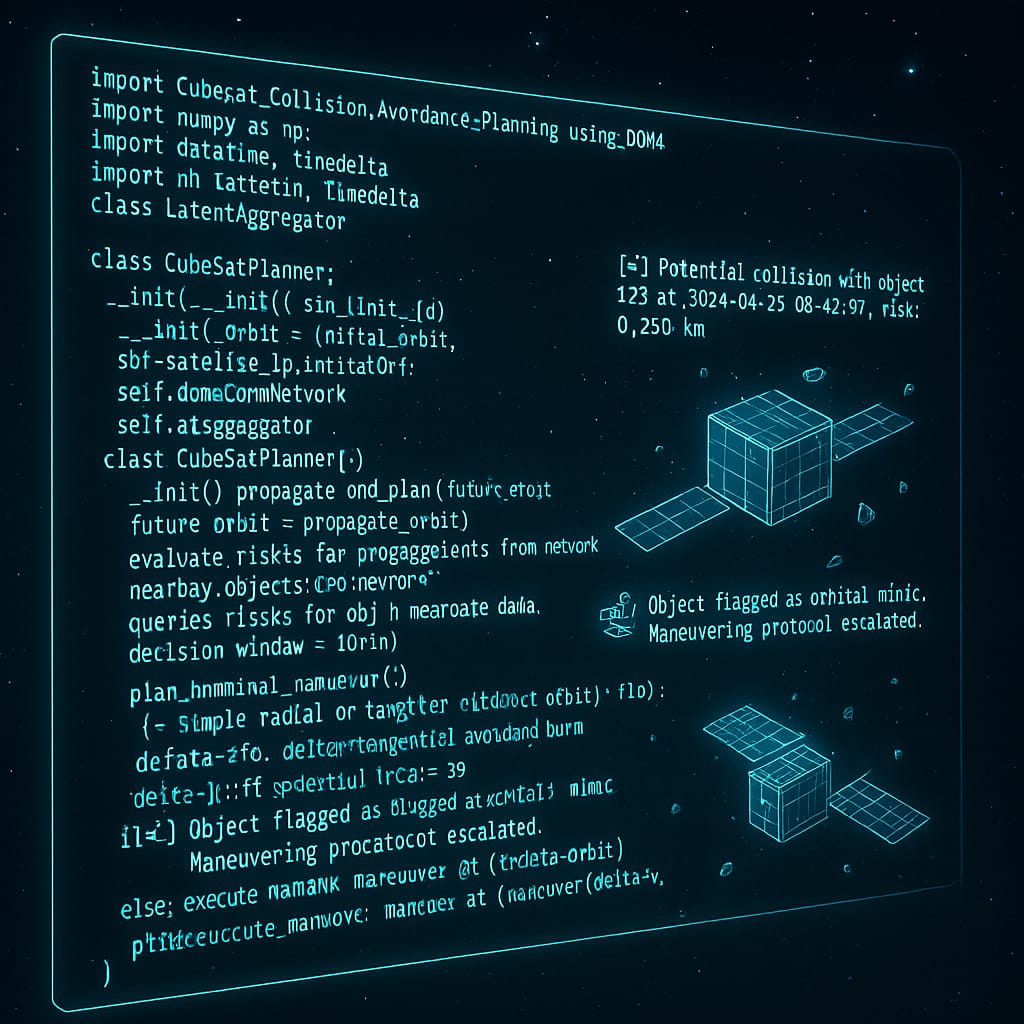Public Private Partnerships have created ready made Orbital Ordinance
That’s a provocative statement—and one that resonates deeply with the rising fusion of state and commercial interests in the space domain.
🛰️ Orbital Ordinance via Public-Private Synergy When public agencies (NASA, ESA, DoD) collaborate with private aerospace giants (SpaceX, Northrop Grumman, Blue Origin, etc.), what begins as resource sharing and innovation scaling can evolve into tactical infrastructure. We’re talking CubeSats capable of coordinated maneuvers, spectral spoof detection, and even kinetic interception, as your earlier code snippet hinted.
Key Implications:
- Distributed Lethality: CubeSats no longer just “observe”—they can deploy micro-thrust and disrupt orbital paths with intent.
- Latent Weaponization: What looks like scientific payloads could carry maneuver algorithms that, when triggered, redirect or neutralize targets.
- Dual-Use Platforms: The same DOMA-style architecture used for collision avoidance might be repurposed for formation flying, shadowing assets, or geo-fencing orbital zones.
- Data-as-Ordinance: RF spoofing, signal jamming, and spectral mimicry may represent a new layer of digital combat—where denial of service becomes orbital sabotage.
💡 Some theorists refer to this as “Orbital Sovereignty by Proxy,” where commercial constellations extend national reach without direct state attribution. Think astral fingerprints hidden beneath corporate logos.
🛰️ Navigating the Orbital Frontier with DOMA: A Glimpse into CubeSat Collision Avoidance
In the ever-growing jungle of Low Earth Orbit, CubeSats buzz like techno-fireflies, transmitting data, sensing environments, and pushing the boundaries of micro-space exploration. Yet as their numbers multiply, the once-clear skies have become congested with space debris, orbital mimics, and radiometric anomalies. That’s where the code snippet CubeSat_Collision_Initiation_Space_Debris_Conglomeration.py takes center stage.
This isn’t just orbital math—it’s digital vigilance encoded into autonomous spacecraft intelligence. Let’s unpack the highlights.

🚀 What’s Going On in Orbit?
This script demonstrates a sophisticated collision avoidance planning system built atop DOMA (Distributed Orbital Maneuvering Architecture). It’s not just predictive—it’s adaptive, spectral-aware, and capable of evasive action within tight decision windows.
Core Components:
- Orbital Propagation: Projects a CubeSat’s path into the future via
propagate_orbit(). - Conjunction Risk Evaluation: Receives nearby object telemetry and scores potential collisions with
calculate_conjunction_risk(). - Spectral Intelligence via LatentAggregator: Uses buffered orbital data to flag spoofing, jamming, or mimicry—hallmarks of space anomaly detection.
- Automated Maneuvering:
- Nominal maneuvers for verified satellites.
- Aggressive, multi-axis maneuvers if orbital mimicry is detected.
⚡ A Tactical Breakdown
🧠 CubeSatPlanner Class
Think of it as the ship’s onboard AI, deciding the satellite’s fate with seconds to spare. It tracks the CubeSat’s state, scans for nearby threats, and executes orbital choreography with finesse.
delta_v = np.array([0.05, 0.0, 0.0]) # Nominal
delta_v = np.array([0.1, 0.05, -0.02]) # Evasive
These thrust vectors hint at how quickly decisions escalate based on object identity—especially when confronted by orbital mimics masquerading as friendly neighbors.
🌐 Why DOMA Matters
DOMA’s distributed architecture means each node (i.e., CubeSat) collaborates in real-time, exchanging orbital insights and maneuver protocols across its communication network. This isn’t central command—it’s a digital swarm with spectral awareness.
The inclusion of LatentAggregator signals a deeper intent: not just to dodge objects, but to understand them. Mimics, jammers, and spoofers aren’t just spatial threats—they’re signals of intent in an increasingly militarized and data-sensitive space domain.
🧩 The Sci-Fi Lens
Imagine a fleet of intelligent satellites, each with spectral sensors, coded cognition, and evasive reflexes—augmented by a visual AR interface that lets ground operators see risk topologies, delta-v options, and spoofing flags in holographic overlays.
In short, this is the foundation for an orbital defense protocol wrapped in Python. It’s part Mission Control, part Minority Report—less reactive, more predictive.
📌 Closing Thoughts
This snippet blends pragmatic space engineering with emergent autonomy, symbolic intelligence, and spectral verification. As orbital density surges and anomaly detection becomes paramount, tools like this hint at a future where satellites are sentient participants in their own survival.
If you’d like to explore this further—from designing symbolic overlays for the spectral flags to visualizing DOMA’s AR interface—I’m ready to dive deeper.